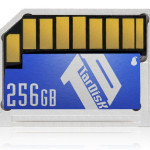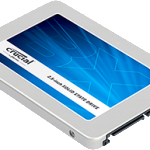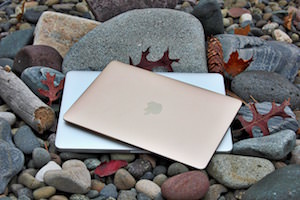I sometimes get caught up in the tech specs, thinking that a tiny performance advantage really matters: For most people, the small differences between Solid State Drive (SSD) models just isn’t worth quibbling over. In fact, you’re more likely to gain more work “performance” if you bring an apple to your desk so you don’t have to leave your workspace just to grab a snack.
The more important performance gain is simply ditching your old and slow traditional hard disk drive found in earlier Apple MacBook Pros (pre-Retina) by moving to an SSD.
The Big Question: Is the Price Right for the Storage Space You Need?
The cost of SSD storage has finally dropped low enough to make it a reasonable buy for many MacBook Pro owners. Of course, the newer MacBook Pros with Retina Displays all include solid-state flash-based storage, but there’s millions of MacBooks and MacBook Pros that still contain powerful processors that are only hampered by slow spinning hard drives. If you use an older MacBook Pro, you can give yourself a nice upgrade with an SSD — plus extend the life of your investment.
To start your upgrade process, first you need to determine how much storage you really need right now . . . and what you’ll need in the next year or so.
If you don’t know how much you’re using, you can always launch the Apple Disk Utility app from within the Utilities folder in your applications folder. Select your drive in the upper left and look at the bottom of the app window to learn the size of your drive and how much space you have available. If you have a 500 GB hard drive and you’re only using 180 GB, you can likely get away with a 250 GB SSD. If you’re using more than 300 GB — lots of photos and videos, for instance — you’ll have to buy a 480 GB or larger SSD.
How Fast Is Fast?
Typically, the speed at which your Mac can read data from an SSD will be somewhere around 5x as fast as a traditional hard drive. And the speed at which your Mac can write data to the SSD? At least 2x as fast.What this really means for you is that apps will open and launch with just a single bounce on the dock. You’ll rarely see the spinning beach ball mouse icon, making your Mac feel as if it’s thinking faster. Apps like iPhoto will feel snappier as you open up events and edit photos. Mail will still download at the speeds offered by your WiFi, but interaction will improve. Your MacBook will wake from sleep faster, plus it’ll reboot or launch cold in 15-20 seconds instead of a minute or longer.In short, you’ll likely enjoy using your older MacBook or MacBook Pro much more — and if you’re like me, you’ll wonder why it took you so long to upgrade to an SSD.
Which SSD Should You Buy?
Some SSDs are faster than others, but don’t worry about it too much: Figure out how much storage you need and then buy a decent SSD drive that is a SATA III (6 Gbits/s) model at price that matches your budget — the prices of older generation SSD drives slowly drop over time while newer (slightly faster SSD drives with newer encryption) start off at higher prices. I recommend simply picking one of two brands — Crucial or Samsung — that boast consistently good quality and user reviews for Mac owners.
Personally, I’m a fan of the Crucial M500 line because of its outstanding price-to-quality ratio.
Here are three can’t-go-wrong options available from Amazon.com:
- Crucial BX200 — 240 GB, 480 GB, or 960 GB
- Crucial MX200 — 250 GB, 500 GB, 1 TB
- Samsung 850 EVO — 120 GB, 250 GB, 500 GB, 1 TB or 2 TB
One more thing — when you go to install your SSD, you’ll need some tiny screwdrivers. If you’re lucky, you can use a cheap set, but if you find a stubborn screw, you’ll wish you spent five or six dollars extra for one of these:
How to Upgrade SSD on MacBook Pro and Air
If you’re looking for a bit more detail on the upgrade process, check out these guides:
- 7 Steps: How to Upgrade Your MacBook Pro with a Solid State Drive (SSD)
- How to Upgrade a Retina MacBook Pro SSD Drive in 5 Steps
- 5 Steps: How to Upgrade Your MacBook Air SSD
What About Using Your SDXC Card Slot for More Mac Storage?
If you want more on-board, nearly built-in storage — but don’t want to actually remove your existing hard drive — you have two good options, both of which are tiny flash-based drives in the shape of camera memory cards. They plug into the SDXC card slot on your MacBook Pro, and they work with all MacBook Airs and Retina MacBook Pros that have SDXC card slots.

The TarDisk Pear system is a tiny drive that you can combine with your built-in drive to create a single “fused” storage system on your MacBook Air or Pro.
For all intents and purposes, the Transcend JetDrive Lite acts like a little USB thumb drive — but it fits flush into the SDXC card slot instead and appears on your Mac like an external drive that is always on, always available. It appears as a separate storage option to your Mac’s operating system. Quite handy.
The TarDisk Pear system, on the other hand, also uses the SDXC card slot but it combines with your built-in storage to form a single “fused” drive. If you want a near-permanent — but easy storage solution for your MacBook Air or Pro — the TarDisk Pear system might be your best bet.
Of course, if you use your SDXC card slot for loading photos, you can pick up a small USB-based card reader like the Kingston Digital MobileLite G4 Card Reader to easily load photos and video off of your SD camera cards through a USB port.









